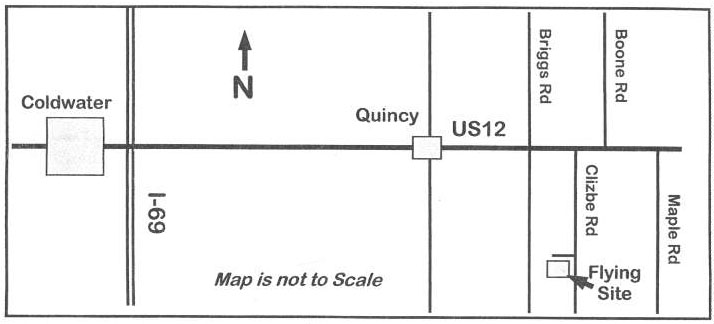|
EFO Meeting WEDNESDAY April, 13
The April EFO meeting will be on a WEDNESDAY, April 13. It will be at Ken Myers's house, starting at 7:30. Everyone with an interest is welcome.
This will be out last indoor meeting of the season. We've had some great ones all through the winter. Bring your latest projects for show and tell. Also, bring along what you picked up at Toledo this year to share. See you then!
E-Power for a 1/4-scale Spacewalker Revisited
From Rich Sievert via email
Hi Ken,
Thanks for your help on motor selection. (March 2011 Ampeer KM) Lucien Miller has one S-5535-160 (6579-160, 811g) in stock at this time. Another possibility is a rewound S-5525-255 (6568-225, 638g) that would give between 300-330 Kv on 8S2P A-123 batteries. He thought that would be a good match and he is checking on price and delivery for that option.
If I may impose on your expertise again, does the rewound 5525 make sense? Motor weight, volts, amps, watts, and revised Kv all seem to fit.
Thanks again.
Cheers,
Rich
Hi Rich,
I think the rewound S-5525-255 is a viable option. The rewind looks like it would be an 8-turn with a Kv of about 340 (6568-340, 638g).
Very roughly, the 225 is a 12 turn motor. (12 turns * 225Kv) / 8 turns = 337.5 Kv. This is not exact but shows that Lucien is right in the ballpark.
I don't think you need to go to an 8S2P. I believe that a 7S2P "A123" 2300mAh pack would suit your needs with that rewound motor. It should pull 70ish amps with a 20 inch diameter prop with either an 11 or 13 pitch. All of the 5525 series motors are rated at 65 amps continuous, from the 16-turn to the 12-turn, which seems odd, as the 12-turn and 14-trun should be rated for a higher amp draw than the 16-trun. An 8-turn should easily handle the 70ish amps you are looking for using the parallel pack.
Of course the 5535-160 was what I recommended, but the 5525 would save a bit of weight motorwise. I'd call it a toss up.
Later,
Ken
Return to "What's In This Issue"
How Long Will Rich's Plane Fly
From Willie McMath via email
Hello Ken,
Enjoyed your latest issue. I was wondering about the power supply of 12 or 14 cell
A123s in the Spacewalker article. How much flight time with that set up?
Willie McMath
Hi Willie,
14 "A123" 2300mAh cells in either series at 35 amps or a 7S2P (14 cells) at 70 amps gives approximately 7 minutes of flight time, depending on the plane, pilot, atmospheric conditions, flying style, etc. Actually, the number of cells in series doesn't matter. I set almost all of my "A123" setups to pull about 35 amps static (I'm not using any parallel packs) and use the timer on my transmitter set for 7 minutes. For my flying style and types of planes it is no problem.
I put between 1750mAh and 1950mAh back into the pack, according to my CellPro 10S, depending on winds and how 'wild' I get during a flight. ;-)
On the other hand, when Keith Shaw flies my Super Stearman and really 'presses' it, it becomes a 5 minute 30 second flight. Guess how I know? ;-)
Later,
Ken
Return to "What's In This Issue"
Is It a Prop Range or Not?
From Arthur Deane President: Midwest RC Society
Via email
Ken,
That was a very good and interesting presentation last night at the Midwest RC Society meeting. One of the best we have had. The write up on the Web site is great and I hope it gets a lot of publicity and viewers. You certainly put a lot of work into it. I am sure everybody learnt something.
The statements on prop ranges surprised me. I will have to do a little study to understand theory some more.
Thanks
AJ
Hi Arthur,
Thank you very much. It was a lot of fun to put it all together.
It turns out that there is more wrong with the Horizon Hobby prop suggestions for the E-Flite Power 25 (3554-870, 190g) than just listing a range when it is not a range at all.
Horizon Hobby says that the Continuous Current rating is 32 amps and the burst rating is 44 amps for 15 seconds on the specs page and 30 seconds on the instruction sheet. The burst rating is only for intermittent use like in a 3D type plane or where the user wants to 'use' the motor to its maximum. The instructions for the Power 25 give only one example for this motor using a Li-Poly battery.
ESC: E-flite 40A Brushless
Prop: APC 12x8E
Battery: Thunder Power PRO LITE 4200mAh 3S2P
36.8 Amps, 10.8 Volts, 397 Watts, 7410 RPM
The amp draw in their example is above the recommended Continuous Current.
Keep in mind that the numbers given by any one manufacturer are based on what they are willing to support with a warranty. If you look at an almost identical Scorpion S-3026-12 (it used the number of winds not Kv after the dash) outrunner (3844-840, 189g), you'll see an entirely different set of specifications that Innov8tive Designs/Scorpion was willing to warranty for an almost identical motor.
Using diameter and body/case length the 190g E-Flite Power 25 would be a 3554-870 and 189.3g Scorpion S-3026-12 would be a 3844-840. Based on weight, Kv and physical size, these two motors appear to be quite similar. The expected performance should also be close. Drive Calculator suggests the following for the motors using the same 3200mAh 3S Li-Poly and APC 14x7E prop. A 14x7 is the largest prop recommended by Horizon Hobby for this motor.
E-Flite Power 25: 10.48v, 43.3 amps, 453.5 watts in, 6798 RPM
Scorpion S-3026-12: 10.49v, 42.1 amps, 442.1 watts in, 6763 RPM
The APC 14x7E is right at the 44 amp maximum suggested by Horizon Hobby on a 3S pack and would only be used in a 'limited' burst situation, such as a 3D plane. The Scorpion motor was rated at 60 amps continuous and at 42.1 amps with the same prop, it is well within a 'safe' range for typical use in sport and sport scale planes.
If the APC 14x7E is used with a 4S pack on the Power 25, the amp draw should be about 65.6 amps and the input watts about 888.2. Horizon Hobby suggests, on the motor instruction sheet, a maximum input watts of 600 for this motor.
The other prop suggested by Horizon Hobby on both the specs Web page and in the instructions is an 11x8. Using the same 3200mAh 4S Li-Poly battery and an APC 11x8E, Drive Calculator yields the following results.
E-Flite Power 25: 13.85v, 49.2 amps, 682.1 watts in, 9,333 RPM
Scorpion S-3026-12: 13.89v, 47.3 amps, 657.3 watts in, 9,216 RPM
The 11x8 on 4S is significantly above the burst amp rating of the E-flite motor, but it is still in the 'safe' range for the Scorpion motor.
On the instruction sheet, the E-Flite motor is rated to a maximum of 600 watts in, while Scorpion rated its motor at 1000 watts in. Why the difference? It is what they are willing to warranty.
If Horizon Hobby were to follow what appear to be their own guidelines of recommending a prop near the burst amp draw, they should have suggested an 11x7 for use with a 4S pack, not an 11x8.
Either way, Horizon Hobbies is suggesting props that are used at the maximum 'burst' amp draw and they are not a range, but maximum for 3S and 4S application.
One other interesting note is that they recommend the use of a 40-amp to 45-amp ESC on the specs page and 40-60 amp ESC on the instruction's page. At the 'burst' rate of 44 amps a (44 * 1.25 =) 55 amp or larger ESC would be a better choice.
Following their 32-amp continuous amp draw rating, Horizon Hobby could have suggested;
4S up to 10x7 (DC suggests an APC 10x7E draws about 33.8 amps - close enough)
3S up to 12x7 (DC suggests an APC 12x7 sport draws about 33.6 amps - close enough)
At those amp draws, a 40-amp ESC could be considered sufficient.
Another Example:
The Dualsky Xmotor 3548CA-5T (http://www.2dogrc.com/product/dualsky-xmotor-3548ca-5t-450w-32-size) (no diameter and length available) shows a prop 'range' of 10x5 to 14x7. It has a 'burst' rating of 40 amps. It does not list a cell range. The Web page just notes 4 cells. DC suggests that with a 4S Li-Poly and an APC 10x5E the amp draw is 37, which is already close to the 'burst' amp rating. Using an APC 14x7E and the 4S Li-Poly the anticipated amp draw is off of DC's scale! With the APC 14x7E and a 3S Li-Poly the predicted amp draw is 52.2 amps. That is too high once again. It appears that their whole 'range' is "wrong".
If they wanted to denote props near the 'burst' rating for 3D type flying they should have used:
3S up to 12x6
4S up to 10x6 (DC suggests the APC 10x6 sport - 39.8 amps)
A 'safer' suggestion of 80% of the 'burst' amps for sport and sport scale flying would be 32 amps. The suggested props would look like this:
3S up to 11x5.5
4S up to 9x6
One more example
The AXI 2826/12 (3554-760, 181g), according to the information on its Web page, uses 3 - 5 Li-Poly cells in series and 11x6E to 13x8E props. It has a maximum amp rating of 40. The first problem that arises is that there is no APC 11x6E prop. There is an APC 11x6 sport. On a 5S Li-Poly using the 11x6 sport DC suggests an amp draw of 38.6 amps, which is, once again, near the maximum. For a 4S pack and an APC 13x8E, DC suggests a 45.1 amp draw, which is over the maximum. With a 3S pack and the APC 13x8E prop DC suggests a 29-amp draw, well under the maximum! I'm not sure how they even came up with the suggestion of a 13x8E.
For the 3D folks and those wishing to press the motor to the maximum:
3S up to15x7 Metts e-prop
4S up to 13x6.5E
5S up to 11x6 sport
Using the 80% of the maximum or 32 amps
3S up to 14x7E
4S up to 11x7 sport
5S up to 10x7E
As you can see, we are at the mercy of the suppliers who supply quite useless information.
One reason I've settled on using Scorpion motors is because Lucien Miller of Innov8tive Designs provides prop data sheets for many of the motors and the Scorpion motor data is more complete than many other brands.
Here is a link to the prop data chart for a typical Scorpion motor.
I also like the way our friend Dave Thacker has the information about motors on his Radical RC Web site. While not as accurate as Lucien's tested data, it is better than most.
I suppose you'll be doing some of your own research on this soon. I'm pretty sure that you'll reach the conclusion that the prop recommendations are not a range at all.
Later,
Ken
Return to "What's In This Issue"
Electric Plane Performance Calculations
A Follow-up email from Arthur Deane
Further to your explanation of manufacturers' propeller call out where maximum voltage does not equate to largest propeller, I have a question.
I have been doing some performance calculations on a potential plane.
Motor 800 Watts, 770 Kv, 2.4 amps idle current, resistance .02 ohms
(Sounds like the E-flite Power 32 KM)
Manufacturer recommends 3 - 4 Li-Poly, 12 -16.8 volts, 42 amps continuous, 60 amps 15 seconds max, 60-amp ESC
Prop Range: 11x7 to 14x10
We know from you explanation that a 4-cell Li-Poly should use the 11x7 prop.
A plane offered by the same manufacturer, not surprisingly, recommends use of the above motor. They suggest a 13x6.5 prop for standard flying and a 14x7 for high performance and a 60-amp ESC.
(Sounds similar to what is recommended on the E-flite Extra 300 32e ARF KM)
Analysis with MotoCalc (4 cell Li-Poly) (http://www.motocalc.com) suggests
11x7: 552 watts (in KM) 40 amps, Motor std (dia./pitch = 64% KM)
12x6: 662 watts (in KM) 45 amps, Motocalc optimum recommendation (dia./pitch = 50% KM)
13x6.5: 762 watts (in KM) 57 amps, Very high current for recommended ESC (dia./pitch = 50% KM)
14x7: 848 watts (in KM) 64 amps, Warning of high motor temperature with full throttle (dia./pitch = 50% KM)
Analysis with Drive Calculator (4-cell Li-Poly) suggests
11x7: 682 watts (in KM) 42.7 amps
12x6: 725 watts (in KM) 49 amps
13x6.5: 904 watts (in KM) 61 amps - overload of recommended ESC
14x7: select smaller propeller
My question is, are the performance simulation programs too conservative or the plane manufacturers overly optimistic?
Regards,
AJ
Hi Arthur,
As I noted in my previous email reply, the suppliers may state anything they want to cover with a warranty as their motor power recommendations. The E-flite Power 32 (4250-770, 200g) has essentially the same specifications as the Scorpion SII-3026-710 (3852-710, 205g). It has the same almost everything, including the Kv. Check the August 2010 issue of the Ampeer where I test the Scorpion motor. The tested Kv is about 770, the same as noted for the E-flite product.
Scorpion chooses to rate, essentially the same motor, like this:
Max Continuous Current: 60 Amps
Max Continuous Power: 1000 Watts (in KM)
Notice that Scorpion chooses NOT to play the silly, and somewhat meaningless, "burst game."
1000 watts in / 60-amps = up to 16.67 volts
A 4-cell Li-Poly pack's voltage will not provide 1000 watts in at 60 amps. With a 5-cell Li-Poly pack,the amp draw would have to drop to about 55 amps so as not to exceed 1000 watts in.
The specification sheet for the Power 32 indicates:
APC 13x6.5E, 4S1P 3800mAh Li-Poly, 60-amp ESC, 14.4 Vin, 55 amps, 792 watts in - RPM not given
This data pretty much matches the MotoCalc prediction you quoted for a 13x6.5 prop. I assumed the props that you mentioned were APC 'E' thin electric types.
The reason that Drive Calculator doesn't match more closely is that the data for the Power 32 is "iffy" because it calculates the Kv as 868 based on the data entered by the individual doing the posting.
If you look at the Scorpion SII-3026-710 0-deg timing, which I tested and posted to Drive Calculator, you'll see that Drive Calculator predicts the following when using the APC 13x6.5E prop at 3.7v per cell under load; 14.8Vin, 53.8 amps, 795.6 watt in. Again, this is pretty close to the MotoCalc prediction for the Power 32 and inline with what Horizon noted for this motor's performance on its instruction sheet.
The answer to your question, "Are the performance simulation programs too conservative or the plane manufacturers overly optimistic?" is that there really is no single answer.
Many folks, myself included, have stated that the maximum power for the average or typical outrunner is 3 watts in for each gram of motor weight. That would suggest a 200g outrunner is a 600 watts in motor. E-flite says that their Power 32 is an 800 watts in motor and Scorpion says that the SII-3026-710 is a 1000 watts in motor. Why the discrepancy?
3 watts in per gram of motor weight for a typical outrunner only applies to planes that fly "on the wing". It does not apply to planes where the throttle is continually and quickly throttled between maximum power for a few seconds and then a lower power. Planes that have taken on the name of 3D types and the type of "gliders" called warm-liners or hot-liners use the abrupt throttling. Also, even though not abruptly throttled, racing planes are pushed much above the typical level. Winning is everything!
There is a spreadsheet of several hundred planes and power systems at the EFO Web site. The worksheet on the spreadsheet named "outrun" contains only data for planes using outrunner motors. The planes are listed by their wing cube loading levels. The planes with the highest watts in per pound have been sorted so that they are found near the end of each list. Many of them exceed the 3 watts in per gram of motor weight by quite a bit. In all of the levels, 30% or more of the noted power systems exceed the 3 watts in per gram of motor weight recommendation.
Here are a few quick examples.
WCL Level 1 (up to 3 oz./cu.ft.)
Insane Foamies Razorback bipe FlyRc Dec. '09, 4.14 watts in per g of motor weight
WCL Level 2 (3 oz./cu.ft. to 5 oz./cu.ft)
ICARE Avia (sailplane) FlyRC Sept. '10, 5.64 watts in per g of motor weight
Aeroworks Profile Extra 260 FlyRC Dec. '08, 4.43 watts in per g of motor weight
WCL Level 3 (5 oz./cu.ft. to 7 oz./cu.ft.)
Cermark Victor FlyRC (warm-liner), 4.31 watts in per g of motor weight
Hyperion Samson 35e bipe FlyRC Mar. '11, 4.92 watts in per g of motor weight
WCL Level 4 (7 oz./cu.ft. to 10 oz./cu.ft.)
Hanger 9 Edge 540 33% (covey), 5.37 watts in per g of motor weight
Wild Hare RC Slick 540 FlyRC May '10, 5.93 watts in per g of motor weight
WCL Level 5 (10 oz./cu.ft. to 13 oz./cu.ft.)
E-Flite LR-1A Pogo FlyRC Mar. '11, 4.36 watts in per g of motor weight
Aeroworks .60-.90 Yak 54, 4.46 watts in per g of motor weight
WCL Level 6 (13 oz./cu.ft. to 17 oz./cu.ft.)
Great Planes Revolver mid-wing aerobatic/pattern, 4.76 watts in per g of motor weight
Fliton Edge 540 Freestyle, 3.82 watts in per g of motor weight
The reviewers/owners are willing to run their motors at these high performance levels either because they perceive that being used intermittently at the maximum power level is "safe" or they are trying to keep the weight down for maximum performance and are willing to face the consequences. How long a given outrunner motor lasts at these power levels is anyone's guess. I've never seen any updates of the reviews noting how well the power system held up over time.
Looking at the above information shows a range of from 3.82 watts in per g of motor weight to 5.64 watts in per gram of motor weight.
If the Power 32 was used in an intermittent maximum power application type mission, could it be considered an 800 watts in motor as suggested by Horizon Hobby? That seems likely. Would a calculation program question that? That seems likely as well.
On a practical level, let's look at the outrunners that I actually use.
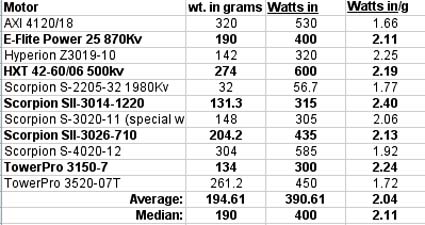
My Outrunners
You can see that I am extremely conservative when it comes to watts in per gram of motor weight. My average is only 2.04 watts in per gram with 2.40 being the highest. Why? I use a heavier motor to balance the plane. An extremely "odd" thing about these numbers is that my best performing plane, the ElectroFlying Fusion, has the lowest watts in per gram of motor weight.
You didn't note the type or mission of the plane that you are considering. Since you noted mostly flat-pitched props (dia./pitch = 50% or less), I have to assume that it is some 3D capable airframe, since I don't think you'd be flying a warm-liner/hot-liner or racing plane.
If you decide to use the Power 32 at 800 watts in on a 4S pack, you should consider an ESC rated for 70 amps or more. That gives you the 80% margin for the amp draw to be in mid-50 range. It looks like an APC 13x6.5E should get you there with either the Power 32 or Scorpion SII-3026-710.
Other sources for Power 32 information:
www.rcgroups.com/forums/showthread.php?t=1282300
APC 13x6.5E, 4S 3850mAh, 15.34Vin, 61 amps, 9210 RPM
APC 14x7E, 4S 3850mAh, 15.4Vin, 60 amps, 9150 RPM
Note that the above numbers look wrong. An APC 14x7E will pull more amps than an APC 13x6.5E on the same motor, ESC and battery.
www.rcgroups.com/forums/showpost.php?p=9486589&postcount=6
APC 15x8E, 3S3P 6000mAh, 10.4Vin, 46 amps, 5880 RPM
APC 13x6.5E, 4S2P 4200mAh, 13.9Vin, 50.5 amps, 8800 RPM
APC 15x8E, 3S2P 4200mAh, 10.48Vin, 52 amps, 6100 RPM
Note that the above numbers look wrong. The amp draw with the 3S3P 6000mAh pack should be higher than the amp draw with the 2S2P 4200mAh pack. It could also be that age and C ratings of the relatively small individual packs making up the larger pack are coming into play.
Ken
Return to "What's In This Issue"
Greetings from Up North
From John Zook via email
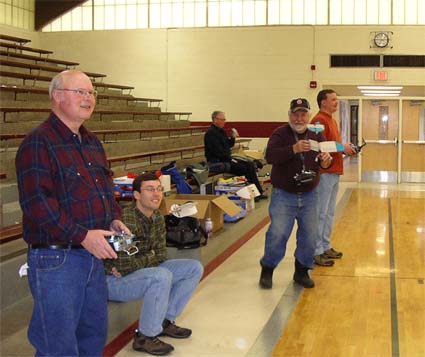
Hi Ken and all EFO members.
The winter season up here hasn't slowed anybody down. With plenty of snow, the sledders have been out in force throughout the area. Inside the fliers have been in force as well. There are many locations from which to choose for indoor flying. Most are gymnasiums and close enough for anybody looking for some flying time.
There are gatherings at Traverse City, Kalkaska, Gaylord, Charlevoix and Alba to name a few. The number and types of aircraft are many including Embers, Vapors, E Flight's UMX Extra 300 3D BNF as well as a few Penguins and assorted helis of every type and size up to 400-size.
What a great way to spend a Saturday afternoon or weekday evening getting together with other fliers and having a whacking great time. Even if somebody has and unscheduled landing, the laughter never stops. There is also lots of good natured ribbing for those who do so.
One of the newest Hobby shops up here is CD Hobbies in Kalkaska. Chris Zolen is an experienced heli pilot with many thousands of hours flying helis in the Army and he teaches RC heli to those who want instruction. He also was instrumental in obtaining usage of the Kalkaska gym for the past two seasons. A look inside his small, but bulging at the seams, shop includes a nice selection of electric aircraft and many indoor planes and helis.
He also is the coordinator of the biweekly Ember races held in the gym. There are lots of laughs watching intrepid pilots attempt to race around the course trying to avoid each other and a wall that comes from out of nowhere.
Decorating your Ember is a must in order to prevent confusion and contact with the wall. Everyone has a good time and no real damage is done. After all we're only flying Embers.
On the other hand the appeal of helis seems to be growing as new people are showing up with an assortment of Co-axial and small CP helicopters. Even kids are showing an interest. Who knows maybe the next IRCHA champ is one those 8-year-olds.
Enclosed are a few pictures: Jim Maine with his Penguin and indoor flying in the Charlevoix Middle School gym.
Next time, I will have some info on my newest build: Sig 1/5 scale Cub.
Cheers,
John
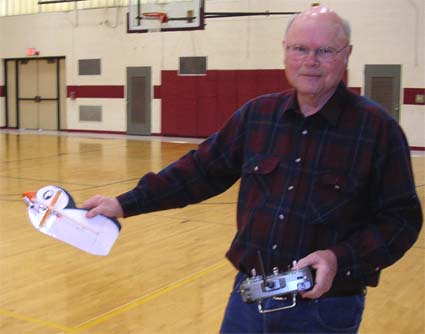
Jim's Penguin flying at Charlevoix
Return to "What's In This Issue"
Don Belfort's Nesmith Cougar Progress Update
From Don Belfort via email
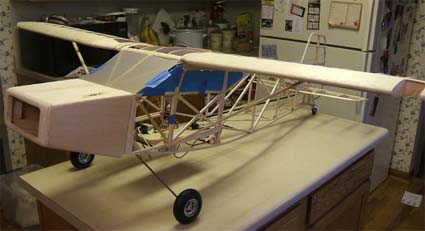
Hi Ken,
Hope all is going well for you!
The Nesmith Cougar is almost ready to cover. Working on the wiring harness for the navigation lights currently.
It's getting closer to Toledo!
Take care
Don Belfort
Return to "What's In This Issue"
Which Motor?
From Brian Amato, Traverse City, MI via email
Ken,
I'll bet you've been asked this question a million times and, maybe you've already responded to it in spades but, I don't know about it.
Which electric motor?
I'm 63 years old and, probably like you, cut my teeth on Cox .049 1/2A engines in just about everything. If it needed a bigger motor, we knew which one to use. Bigger yet, there were always good ol' McCoy .35s, red heads, green heads, etc.
Now there are all of these wonderful electric motors; outrunners, inrunners, brushless, and number designations that boggle the brain.
I've tried to sort it out. This numbers means what the diameter of the case is or the stator or...This one means how many windings. On and on.
But that doesn't answer the simple question most of us still struggle with: "Which electric motor for THIS airplane?"
It's not enough anymore to say "put a 1/2A on it" or "put a .35 on it and it will be just fine". It isn't simple anymore.
You would be doing all of us a great service if you could come out with a simple "electric model airplane motors for Dummies" that takes the mystery out of it. I'm serious as heck!!!
Thanks in advance,
Brian Amato
Traverse City, MI
And
Ken,
I just read the latest Ampeer and have to thank you for going to all that trouble to research the Lazy Bee and what I need to power it. That's really good of you and I appreciate it.
Now all I have to do is go back and read it a dozen more times to figure out what it all means.
I'm sure you're saying "What do you mean...'what it all means'? It's simple as what I said".
Well it is not simple unless these are terms you work with every day and are familiar with them.
Like I mentioned in my previous email, the terms and numbers are not readily intuitive to guys not familiar with them.
"175 watts in" What does that mean? Watt inches? Watts into the system.
Not a clue here. I'll go Google these terms to figure it all out.
You're very kind to go to all this work. Sorry I'm not able to absorb it all as easily as I know you'd like.
Brian
Hi Brian,
The reason that no one has written an "Electric Model Airplane Motors for Dummies" is that there is not one motor that fits a given application like a glow .25 would, for example. I will be doing an upcoming piece on that.
Watts in means what you would read with a power meter (aka wattmeter, whattmeter, etc.) at full throttle. Volts in (Vin) * Amps in (Iin) = Watts in. That is a very basic formula that is used all of the time.
You might want to take a look at "Electric Power Basics" on the EFO homepage.
Scroll down just a little and you will see it. It is best read online with the active links, but there is an Acrobat .pdf version that is best for printing.
Since motors numbers vary so much by there naming, noted in the article I mention above, I've started to use uniform notation so that they can be compared directly.
The E-Flite Power 25 has a diameter of 35mm, case length of 54mm, Kv of 870 and weighs 190g. I annotate it as 3554-870, 190g
Scorpion uses the stator dimension for its numbering system. For the SII-3026-890 the 3026 is the stator dimensions but the diameter is 37.5mm, case length 51.7mm, Kv 890 and weight 205g. I annotate now as a 3852-890, 205
Turnigy TR35-48 Kv 900, weight 163g diameter 35mm case length 48 I annotate as 3548-900, 163g
I hope that you can see that a motor that I annotate as a 2826-1650, 45g would not be in the same group as the above. You should be able to read my annotation as 28mm diameter, 26mm case length with a 1650Kv (whatever that is) and weighs 45g. I hope to clear up some of the naming confusion by always using my annotation after the given name for an outrunner motor in the Ampeer.
One last note on that. The motor above is not equivalent to an AXI 2826 motor, which uses the stator dimensions. I would annotate an AXI 2826/10, diameter 35mm case length 48mm, Kv 920, weight 181g as a 3548-920, 181g. I hope you see that the AXI fits in the same group as the other 35mm diameter motors. You should also be able to see that the Turnigy and AXI are more similar to each other than the Power 25 and Scorpion, while the Power 25 and Scorpion are closer to each other than the other two.
As you can see, all three original motors that I mentioned and the AXI are very close to being the same size and Kv. The major difference is the weight. The Turnigy isn't heavy enough to be considered similar to the Scorpion and Power 25 but it is closer to the AXI.
Weight, or mass, has to do with power absorption ability. I'll have more on exactly what that power ability is in some upcoming Ampeers.
It's not easy to absorb! I've been doing it for a long time and still come up with a ton of 'head scratchers'!
Later,
Ken
Return to "What's In This Issue"
Chris Hass Flies at Operation Homefront Benefit
Joe Hass & Ken Myers
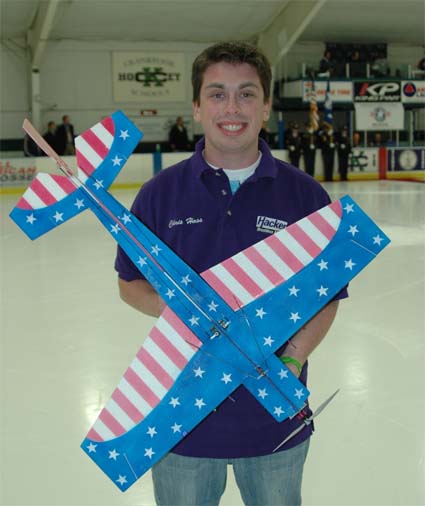
I received a phone call from a fellow putting an Operation Homefront function together. (www.operationhomefront.net) It was to be held at a hockey arena. He wondered if there was anyone in the area that might be able to do an RC flight demo. He was thinking helicopter. I informed him that it was possible to do indoor plane flying as well. He was interested and I gave him information to contact Joe Hass, "Mr. Organize Indoor Flying". Here is a follow up email from Joe.
Thanks for giving our names for the Operation Homefront "Indoor Fly Over". Chris flew a 2-minute routine to "Born in the USA" by Bruce Springsteen. He flew his own design Edge with lights. Blew the crowd away! The only problem he had was that the airplane froze on the ice as he was waiting to take off.
I plan on writing it up and submitting an article to AMA.
Thanks,
Joe Hass
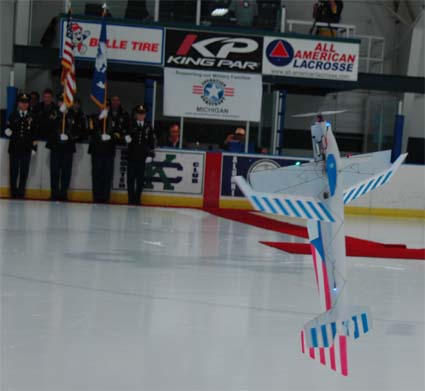 Return to "What's In This Issue"
Return to "What's In This Issue"
Put This One On Your Event Schedule!
Keith Shaw Birthday Party Electric Fly-In
From Dave Grife grifesd@yahoo.com
The Balsa Butchers will once host the "Keith Shaw Birthday Party Electric Fly-In" at their field near Coldwater, MI. This is the 10th Anniversary of this event. The event will take place on June 4 and 5, 2011.
Contest Director: Dave Grife - E-mail:
grifesd@yahoo.com or Phone: 517.279.8445
Please e-mail or call with any questions
The Flying Field will be open Friday, June 3 for early arrivals
Saturday, June 4, hours are from 9 a.m. 'til 5 p.m.
Sunday, June 5, hours are form 9 a.m. 'til 3 p.m.
Landing Fee is $10 for the weekend.
Directions: Quincy is approximately 4.5 miles east of I-69. Clizbe Road is approximately 1.6 miles east of Quincy. The Flying site is approximately 1.5 miles south of US-12 on the west side of Clizbe Road.
|




